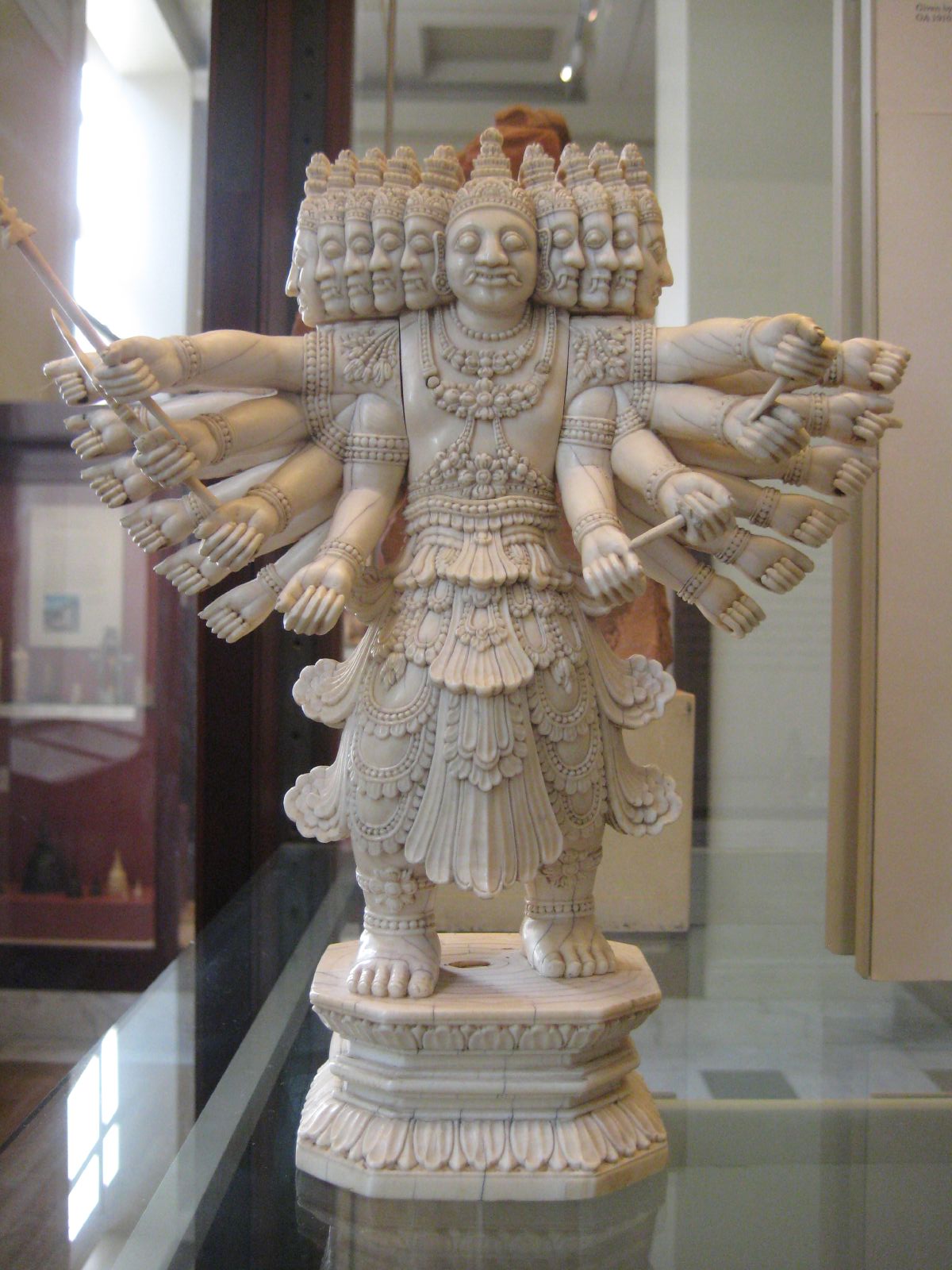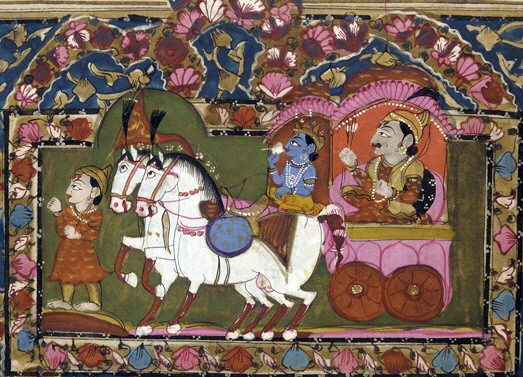|
Ilvala
Ilvala () and Vatapi were rakshasas and brothers. Legend has it that both were vanquished by the sage Agastya. Rakshasa They ruled from Badami, formerly known as Vatapi, named after rakshasa king Vatapi. According to the Mahābhārata, Vatapi ruled the area along with Ilvala. Once Ilvala hosted a tapasvi Brahmin with reverence and asked him to grant a boon. He desired to have a son equal to Indra. But the sage did not oblige. Following this, his anger turned to hatred against all Brahmins and mendicants. Ilvala and Vatapi took a grudge against all sages. Vatapi knew the art of transformation and had the power to change into any life form. Ilvala knew the ‘Mritasanjivani’ mantra to bring back the dead. They used these powers to loot and kill. Ilvala invite a brahman to a feast and Vatapi would turn himself into a Goat. The Bhagavata Purana mentions that Ilvala had a son named Balvala, who used to disturbed the sages present at Naimisha forest when the sages heard the n ... [...More Info...] [...Related Items...] OR: [Wikipedia] [Google] [Baidu] |
Badami
Badami, formerly known as Vatapi, is a town and headquarters of a taluk by the same name, in the Bagalkot district of Karnataka, India. It was the regal capital of the Badami Chalukyas from CE 540 to 757. It is famous for its rock cut monuments such as the Badami cave temples, as well as the structural temples such as the Bhutanatha temples, Badami Shivalaya and Jambulingesvara Temple, Badami, Jambulingesvara temple. It is located in a ravine at the foot of a rugged, red sandstone outcrop that surrounds Agastya lake. Badami has been selected as one of the heritage cities for HRIDAY - Heritage City Development and Augmentation Yojana scheme of Government of India. Nearest Railway Station is Badami Railway Station which is just 2 km from Badami city. Nearest Airport is Hubli Airport which is 109 km away from Badami. History Pre-historic and epic The Badami region was settled in pre-historic times, with evidence by megalithic dolmens. In the local tradition, the ... [...More Info...] [...Related Items...] OR: [Wikipedia] [Google] [Baidu] |
Vatapi
Badami, formerly known as Vatapi, is a town and headquarters of a taluk by the same name, in the Bagalkot district of Karnataka, India. It was the regal capital of the Badami Chalukyas from CE 540 to 757. It is famous for its rock cut monuments such as the Badami cave temples, as well as the structural temples such as the Bhutanatha temples, Badami Shivalaya and Jambulingesvara Temple, Badami, Jambulingesvara temple. It is located in a ravine at the foot of a rugged, red sandstone outcrop that surrounds Agastya lake. Badami has been selected as one of the heritage cities for HRIDAY - Heritage City Development and Augmentation Yojana scheme of Government of India. Nearest Railway Station is Badami Railway Station which is just 2 km from Badami city. Nearest Airport is Hubli Airport which is 109 km away from Badami. History Pre-historic and epic The Badami region was settled in pre-historic times, with evidence by megalithic dolmens. In the local tradition, the Ba ... [...More Info...] [...Related Items...] OR: [Wikipedia] [Google] [Baidu] |
Agastya
Agastya ( kn, ಅಗಸ್ತ್ಯ, ta, அகத்தியர், sa, अगस्त्य, te, అగస్త్యుడు, ml, അഗസ്ത്യൻ, hi, अगस्त्य) was a revered Indian sage of Hinduism. In the Indian tradition, he is a noted recluse and an influential scholar in diverse languages of the Indian subcontinent. He and his wife Lopamudra are the celebrated authors of hymns 1.165 to 1.191 in the Sanskrit text '' Rigveda'' and other Vedic literature. Agastya is considered to be the father of Siddha medicine. Agastya appears in numerous itihasas and Puranas including the major ''Ramayana'' and ''Mahabharata''. He is one of the seven most revered rishis (the Saptarishi) in the Vedic texts, and is revered as one of the Tamil Siddhar in the Shaivism tradition, who invented an early grammar of the Old Tamil language, Agattiyam, playing a pioneering role in the development of Tampraparniyan medicine and spirituality at Saiva centres ... [...More Info...] [...Related Items...] OR: [Wikipedia] [Google] [Baidu] |
Rakshasas
Rakshasas ( sa, राक्षस, IAST: : Pali: ''rakkhaso'') lit. 'preservers' are a race of usually malevolent demigods prominently featured in Hindu mythology. According to the Brahmanda Purana, the rakshasas were created by Brahma when he assumed a body of ''tamas'' (darkness), the beings springing forth and promising to protect the waters of creation. They are often depicted to be man-eaters (''nri-chakshas'', ''kravyads''), acting as embodiments of the powers of evil in the Vedic scriptures. They are offered a distinction from yakshas, their cousins who are depicted to be forces of destruction. The term is also used to describe asuras, a class of power-seeking beings that oppose the benevolent devas. They are often depicted as antagonists in Hindu scriptures, as well as in Buddhism and Jainism. The female form of rakshasa is rakshasi. Hinduism In Vedas The Hymn 87 of the tenth mandala of the ''Rigveda'' mentions about Rakshasas. They are classified amongst the ''Y ... [...More Info...] [...Related Items...] OR: [Wikipedia] [Google] [Baidu] |
Mahabharata
The ''Mahābhārata'' ( ; sa, महाभारतम्, ', ) is one of the two major Sanskrit epics of ancient India in Hinduism, the other being the '' Rāmāyaṇa''. It narrates the struggle between two groups of cousins in the Kurukshetra War and the fates of the Kaurava and the Pāṇḍava princes and their successors. It also contains philosophical and devotional material, such as a discussion of the four "goals of life" or ''puruṣārtha'' (12.161). Among the principal works and stories in the ''Mahābhārata'' are the ''Bhagavad Gita'', the story of Damayanti, the story of Shakuntala, the story of Pururava and Urvashi, the story of Savitri and Satyavan, the story of Kacha and Devayani, the story of Rishyasringa and an abbreviated version of the '' Rāmāyaṇa'', often considered as works in their own right. Traditionally, the authorship of the ''Mahābhārata'' is attributed to Vyāsa. There have been many attempts to unravel its historical growth ... [...More Info...] [...Related Items...] OR: [Wikipedia] [Google] [Baidu] |
Indra
Indra (; Sanskrit: इन्द्र) is the king of the devas (god-like deities) and Svarga (heaven) in Hindu mythology. He is associated with the sky, lightning, weather, thunder, storms, rains, river flows, and war. volumes/ref> Indra's myths and powers are similar to other Indo-European deities such as Jupiter, Perun, Perkūnas, Zalmoxis, Taranis, Zeus, and Thor, part of the greater Proto-Indo-European mythology. Indra is the most referred deity in the '' Rigveda''. He is celebrated for his powers, and as the one who killed the great evil (a malevolent type of asura) named Vritra, who obstructed human prosperity and happiness. Indra destroys Vritra and his "deceiving forces", and thereby brings rains and sunshine as the saviour of mankind. He is also an important deity worshipped by the Kalash people, indicating his prominence in ancient Hinduism. Indra's significance diminishes in the post-Vedic Indian literature, but he still plays an important role in ... [...More Info...] [...Related Items...] OR: [Wikipedia] [Google] [Baidu] |
Mendicants
A mendicant (from la, mendicans, "begging") is one who practices mendicancy, relying chiefly or exclusively on alms to survive. In principle, mendicant religious orders own little property, either individually or collectively, and in many instances members have taken a vow of poverty, in order that all their time and energy could be expended on practicing their respective faith, preaching and serving society. Mendicancy is a form of asceticism, especially in Western Christianity. In Eastern Christianity, some ascetics are referred to as Fools for Christ, whereby they spurn the convention of society in pursuit of living a more wholly Christian life. Religious practice Many religious orders adhere to a mendicant way of life, including the Catholic mendicant orders, Hindu ascetics, some Sufi dervishes of Islam, and the monastic orders of Jainism and Buddhism. While mendicants are the original type of monks in Buddhism and have a long history in Indian Hinduism and the countri ... [...More Info...] [...Related Items...] OR: [Wikipedia] [Google] [Baidu] |
Bhagavata Purana
The ''Bhagavata Purana'' ( sa, भागवतपुराण; ), also known as the ''Srimad Bhagavatam'', ''Srimad Bhagavata Mahapurana'' or simply ''Bhagavata'', is one of Hinduism's eighteen great Puranas (''Mahapuranas''). Composed in Sanskrit by Veda Vyasa, it promotes '' bhakti'' (devotion) towards Krishna, integrating themes from the Advaita (monism) philosophy of Adi Shankara, the Vishishtadvaita (qualified monism) of Ramanujacharya and the Dvaita (dualism) of Madhvacharya. It is widely available in almost all Indian languages. The ''Bhagavata Purana'', like other puranas, discusses a wide range of topics including cosmology, astronomy, genealogy, geography, legend, music, dance, yoga and culture. As it begins, the forces of evil have won a war between the benevolent ''devas'' (deities) and evil ''asuras'' (demons) and now rule the universe. Truth re-emerges as Krishna, (called " Hari" and " Vāsudeva" in the text) – first makes peace with the demons, understands ... [...More Info...] [...Related Items...] OR: [Wikipedia] [Google] [Baidu] |
Saunaka
Shaunaka ( sa, शौनक, ) is the name applied to teachers, and to a Shakha of the Atharvaveda. It is especially the name of a celebrated Sanskrit grammarian, author of the , the , the and six Anukramaṇīs (indices) to the Rigveda. He is claimed as the teacher of Katyayana and especially of Ashvalayana, and is said to have united the Bashkala and Shakala Shakhas of the Rigveda. In legend, he is sometimes identified with Gritsamada, a Vedic rishi. Literature According to the Vishnu Purana, Shaunaka was the son of Gritsamada and invented the system of the four levels of human life. Sūta mahamuni narrated mythological stories to a group of sages headed by Shaunaka maha muni. is attributed to Shaunaka who taught it to others in a satra-yajna (a 12-day very large scale collective yajna) held in Naimisha according to Vishnumitra of Champa town, the commentator of 's commentary of (Hindi)Virendrakumar Verma, Rgveda-prātiśākhya of Śaunaka Along with ; Chaukhambha Sa ... [...More Info...] [...Related Items...] OR: [Wikipedia] [Google] [Baidu] |
Purana
Purana (; sa, , '; literally meaning "ancient, old"Merriam-Webster's Encyclopedia of Literature (1995 Edition), Article on Puranas, , page 915) is a vast genre of Indian literature about a wide range of topics, particularly about legends and other traditional lore. The Puranas are known for the intricate layers of symbolism depicted within their stories. Composed originally in Sanskrit and in other Indian languages,John Cort (1993), Purana Perennis: Reciprocity and Transformation in Hindu and Jaina Texts (Editor: Wendy Doniger), State University of New York Press, , pages 185-204 several of these texts are named after major Hindu gods such as Vishnu, Shiva, Brahma, and Adi Shakti. The Puranic genre of literature is found in both Hinduism and Jainism. The Puranic literature is encyclopedic, and it includes diverse topics such as cosmogony, cosmology, genealogies of gods, goddesses, kings, heroes, sages, and demigods, folk tales, pilgrimages, temples, medicine, astronomy, g ... [...More Info...] [...Related Items...] OR: [Wikipedia] [Google] [Baidu] |
Ugrasrava Sauti
Ugrashravas Sauti (Sanskrit: उग्रश्रवस् सौती, also Ugraśravas, Sauti, Sūta, Śri Sūta, Suta Gosvāmī) is a character in Hindu literature, featured as the narrator of the Mahābhārata and several Puranas including the Shiva Purana, Bhagavata Purana, Harivamsa, Brahmavaivarta Purana, and Padma Purana, with the narrations typically taking place before the sages gathered in Naimisha Forest. He is the son of Lomaharshana (or Romaharshana), and a disciple of Vyasa, the author of the Mahābhārata. Ugrasrava is a bard of Puranic literature. The entire Mahābhārata epic is structured as a dialogue between Ugrasrava Sauti (the narrator) and sage Saunaka (the narratee). The narration (''Bharata'') of the history of Bharata kings by sage Vaisampayana to Kuru king Janamejaya is embedded within this narration of Ugrasrava Sauti. Vaisampayana's narration (''Jaya'') in turn contains the narration of Kurukshetra War by Sanjaya, to Kuru king Dhritarashtra. ... [...More Info...] [...Related Items...] OR: [Wikipedia] [Google] [Baidu] |





.jpg)



